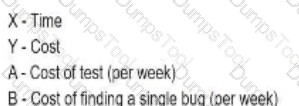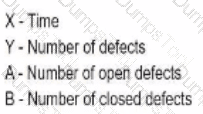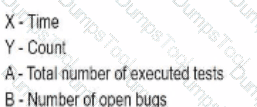As a result of the joint evaluation of a product version with the customer, it has been concluded that it would be appropriate to retrieve an earlier version of the product and carry out a benchmark. Depending on the result, further development will be carried out based on the current version or the retrieved version.
Which mechanism, process, and/or technique will allow the specific version (including the testing work products) of a given software product to be restored?
Which ONE of the following options MOST ACCURATELY describesbranch testing?
Which of the following statements about how different types of test tools support testers is true?
Consider the following list of activities (I to V):
I. Test design
II. Test planning
III. Review test basis
IV. Be a facilitator of a peer review
V. Test monitoring and control
Which ONE of the following options identifies the activities that the test management role is MAINLY focused on?
Which ONE of the following options CANNOT be subjected to static analysis?
A requirement specifies that a certain identifier (ID) must be between 5 and 10 characters long, must contain only alphanumeric characters, and its first character must be a letter. As a tester, you want to apply one-dimensional equivalence partitioning to test this ID. This means that you have to apply equivalence partitioning individually: to the length of the ID, the type of characters contained within the ID, and the type of the first character of the ID.
What is the number of partitions to cover?
You are testing a room upgrade system for a hotel. The system accepts three differed types of room (increasing order of luxury): Platinum. Silver and Gold Luxury. ONLY a Preferred Guest Card holder s eligible for an upgrade.
Below you can find the decision table defining the upgrade eligibility:
What is the expected result for each of the following test cases?
Customer A: Preference Guest Card holder, holding a Silver room
Customer B: Non Preferred Guest Card holder, holding a Platinum room
The four test levels used in ISTQB syllabus are:
1. Component (unit) testing
2. Integration testing
3. System testing
4. Acceptance testing
An organization wants to do away with integration testing but otherwise follow V-model. Which of the following statements is correct?
Which ONE of the following is a GOOD testing practice that is INDEPENDENT of the chosen SDLC (Software Development Life Cycle) model?
Which ONE of the following options contains the statements (I - V) that MOST ACCURATELY characterize acceptance test levels?
I. Acceptance test levels focus on validating and demonstrating readiness for deployment.
II. Acceptance test levels must be performed by an independent test team.
III. Acceptance test levels often require specific support, such as test harnesses.
IV. Acceptance test levels ideally should be performed by the intended users.
V. Acceptance test levels use component specifications as the test basis for the system.
Which ONE of the following is a CORRECT example of the purpose of a test plan?
Which of the following about typical information found within a test plan is false?
Consider the following statements (I to V) about software testing:
I. Can be applied to non-executable work products.
II. Can be used to measure performance efficiency.
III. Can lead to the detection of defects.
IV. Can find defects directly.
V. Can identify unexpected behaviors caused by potential defects.
Which ONE of the following options is the list that characterizes static tests the BEST?
A number of characteristics are given for impact of SDLC on the testing effort.
i.Finishing of requirements review leading to test analysis
ii.Both - static and dynamic testing performed at unit testing level
iii.Frequent regression testing may need to be performed
iv.Extensive product documentation
v.More use of exploratory testing
Which of the following statements is MOST correct?
A company runs a pilot project for evaluation of a test automation tool. Which of the following is NOT a valid object of this pilot project?
Which of the following applications will be the MOST suitable for testing by Use Cases
Consider the followinguser storyand itsacceptance criteria:
User Story:
As a member of the"Agnotoly"association, I want to be able topay the association’s dues through an automatic payment methodso that I can forget about payment deadlines.
Acceptance Criteria:
The member can only pay with‘Agnesis Master’ credit card.
The member must register theircell phone number.
The member must register thecredit cardin the payment system.
The member must select apayment method (monthly or annual).
The member mustaccept the terms and conditionsfor the selected method.
If terms and conditions are accepted, the system sends anOTP(one-time password) to the member’s phone for verification.
The payment method isregistered only after OTP verification.
Once the payment method is registered, the system will charge on the first business day of the following month.
Test Cycle Results:
Members successfully paid dues using the credit card.
Payments were processedmonthly and for over a year.
Which ONE of the following options identifies the acceptance criteria that has NOT been fully covered?
Which ONE of the following options identifies the perspectives through which acollective authorship processgenerates a shared vision of user stories?
In which of the following test documents would you expect to find test exit criteria described9
Which of the following work products cannot be examined by static analysis?
Which ONE of the following activities TYPICALLY belongs to the planning phase of the review process?
Which of the following is a role that is usually responsible for documenting the findings (e.g., action items, decisions, recommendations) made by the review team as part of a typical formal review?
Consider the following examples of risks identified in different software development projects:
[I]. The contrast color ratio for both normal text and large text of a website does not comply with the applicable accessibility guidelines, making it difficult for many users to read the content on the pages
[II]. A development vendor fails to deliver their software system on time, causing significant delays to system integration testing activities that have been planned as part of a development project for a system of systems
[III]. People in the test team do not have sufficient skills to automate tests at the test levels required by the test automation strategy which does not allow production of an effective regression test suite
[IV]. In a web application, data from untrusted sources is not subject to proper input validation, making the application vulnerable to several security attacks
Which of the following statements is true?
For each test case to be executed, the following table specifies its dependencies and the required configuration of the test environment for running such test case:

Assume that CONF1 is the initial configuration of the test environment. Based on this assumption, which of the following is a test execution schedule that is compatible with the specified dependencies and allows minimizing the number of switches between the different configurations of the test environment?
Consider a given test plan which, among others, contains the following three sections: "Test Scope", "Testing Communication", and "Stakeholders". The features of the test object to be tested and those excluded from the testing represent information that is:
Which ONE of the following statements does NOT describe how testing contributes to higher quality?
Which of the following issues cannot be identified by static analysis tools?
The following rules determine the annual bonus to be paid to a salesman of a company based on the total annual amount of the sales made (referred to as TAS).
If the TAS is between 50k€ and 80k€, the bonus is 10%. If the TAS exceeds 80k€ by a value not greater than 40k€, the bonus is 15%. Finally, if the TAS
exceeds the maximum threshold which entitles to a 15% bonus, the bonus is 22%.
Consider applying equivalence partitioning to the TAS (Note: 1k€ = 1000 euros).
Which one of the following answers contain only test cases that belong to the same equivalence partition?
Which ONE of the following options BEST describes black-box test techniques?
A software development company invests heavily in tools to support the entire software development lifecycle, including testing. They have a tool that allows automated creation and installation of builds and subsequent execution of various types of automated tests. Which ONE of the following is a CORRECT statement about this type of test tool?
Which of the following coverage criteria results in the highest coverage for state transition based test cases?
Which ONE of the following options is a practice that does NOT TYPICALLY correspond to a shift left approach?
The following chart represents metrics related to testing of a project that was competed. Indicate what is represented by tie lines A, B and the axes X.Y
A)

B)

C)
D)

An e-commerce site accepts credit cards for processing the payment. The payment processing form has a field for the amount of money to be deducted. The minimum amount of money that can be processed is $10. The credit cards have a limit of $5,000 (Five Thousand). Assume that only integers can be accepted as inputs. Which of the following set of boundary values you will choose for EFFICIENT testing for the amount of money that can be spent?
Which of the following is NOT a typical debugging activity when a failure is triggered by dynamic testing?
Which of the following statements is CORRECT about the value added by a tester to release planning?
Which of the following statements about static testing and dynamic testing is true?
Consider a program that computes the factorial of a number (n). From the specifications you know that:
•If n < 0, a message "Value out of range" must be issued.
•If 0 < n < 100, the program calculates the factorial and returns the number
•If 100 < n < 200 message "Value out of range" must be issued
Which of the following statements about the equivalence partitions is CORRECT?
Which ONE of the following elements is TYPICALLY used to guide testing duringexploratory testing?
In branch testing, what is the significance of a conditional branch in a software program?
Which ONE of the following statements about the objectives of confirmation and regression testing is the BEST?